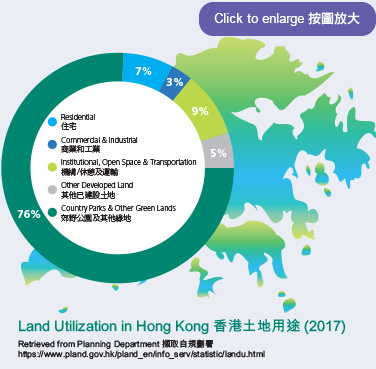Scarce Resource 善用資源 構建未來都市
Earlier this fall, Link submitted a discussion paper to the Hong Kong Government, proposing a holistic approach to deliberating on the city’s strategy for long-term development, with a view to making the best use of a scarce resource – land.
About three-quarters of Hong Kong’s land area is dedicated to country parks and other green spaces – the highest proportion compared to other major cities – leaving a relatively small portion for homes, community facilities, business activities, etc. However, land supply is not a zero-sum game. By efficiently prioritising the use of land resources, reviewing our strict demarcations and instituting green areas in urban planning and building codes, it is possible to strike a balance between living space, urban greenery and natural conservation.
In the discussion paper, we identify placing Hong Kong in the Greater Bay Area (GBA) context as an important step. The GBA initiative plays a pivotal role in driving innovation, technology and business in the region while broadening living options for our working population and retirees alike. With the recent launch of the Hong Kong Section of the Guangzhou-Shenzhen-Hong Kong Express Rail Link and the Hong Kong-Zhuhai-Macau Bridge, coupled with a range of supportive policies, the “one-hour living circle” in the GBA is no longer a pipe dream but a reality that offers tremendous possibilities in city planning.

There is also work to be done on Hong Kong’s existing built-up area. Over 20% of the city’s public rental housing buildings are at least 40 years old, raising safety concerns. In many cases, instead of repair and maintenance, redeveloping old, dilapidated buildings is a more effective way to create a safer and better environment for their residents. We will need a more flexible strategy for streamlining the planning and redevelopment process to accelerate the pace of urban renewal, so as to help improve the vibrancy of the community and economy.
Here at Link, the rejuvenation of local communities is near and dear to our hearts. By completing close to 70 asset enhancement projects – covering both shopping malls and fresh markets – we have turned these properties into vibrant community hubs. Link’s experience in property refurbishment can perhaps shed light on creating value through modernising the built environment.
By making people's quality of life a priority and taking a broad view in city planning, we stand a better chance of developing a city strategy that makes the best use of our land resources for the common good.
George Hongchoy
Chief Executive Officer
我們早前呈交建議文件,提倡從整全的角度探索城市發展,以期更有效利用稀缺的土地資源。
香港把約四分之三的土地規劃為郊野公園和其他綠化用地 — 比例遠高於眾多世界主要城市,而市民居所、社區設施、商業活動等所佔用地十分有限。然而,土地供應並非零和遊戲,只要重新審視土地使用的緩急優次、檢視欠缺彈性的土地用途界限,並將綠化空間納入城市規劃和建築守則,我們將能於生活空間、城市綠化和自然保育三者之間取得平衡。
另外一個重點是必須將香港放於大灣區的發展脈絡。大灣區計劃在推動區內創新、技術和商業發展方面起著重要作用,並且為市民和退休人士擴大生活選擇。隨著廣深港高速鐵路香港段及港珠澳大橋啟用,加上一系列支援措施,大灣區「一小時生活圈」正為城市規劃造就龐大機會。
本港不少舊區亦存在優化空間,公共屋邨有逾兩成樓齡達40年或以上,存在安全隱患。對於大部分的破舊樓宇個案,相較維修保養工程,重建可以重新規劃用地,達到地盡其用,有效提供安全及理想的居住環境。我們需要採取更靈活的策略,簡化規劃及市區重建相關程序,以加快市區重建的步伐,藉以重建社區並推動經濟。
領展的團隊一直致力活化本地社區,至今已完成近70個涵蓋商場和鮮活街市的資產提升項目,成功讓物業蛻變為蓬勃的社區樞紐。領展於物業優化的經驗,正好展示更新建築環境所能創造的多重價值。
透過把市民生活質素放於首位,並以廣闊的眼光進行城市規劃,香港定必能夠訂出切合城市發展需要的策略,善用土地資源,造福市民。
行政總裁
王國龍
Read our discussion
paper here
閱覽我們的建議書:




